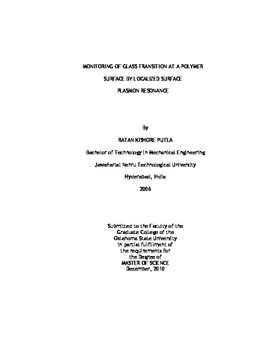| dc.contributor.advisor | Kalkan, Ali K. | |
| dc.contributor.author | Putla, Ratan Kishore | |
| dc.date.accessioned | 2014-04-17T19:53:40Z | |
| dc.date.available | 2014-04-17T19:53:40Z | |
| dc.date.issued | 2010-12-01 | |
| dc.identifier.uri | https://hdl.handle.net/11244/10030 | |
| dc.description.abstract | The present work investigates glass transition on a polymer surface by embedding gold nanoparticles into the polymer and exploiting the localized surface plasmon resonance (LSPR) of the nanoparticle as the probe. The impregnation of nanoparticles into polymer causes a spectral shift in LSPR due to the changing dielectric environment surrounding nanoparticles. LSPR is sensitive to the close vicinity of nanoparticles within a few nm from the nanoparticle surface. Therefore, the diffraction limit of light can be beaten by orders of magnitude and impregnation of nanoparticles into the polymer can be monitored to a spatial resolution down to a few nm. Gold nanoparticles at an average size of 8 nm, were synthesized on poly isobutyl methacrylate (PiBMA) films on glass by physical vapor deposition. Subsequently, time series LSPR spectra of nanoparticle on PiBMA were acquired in transmission mode in a temperature controlled optical cell using a CCD spectrophotometer. The forced convective heating of the sample by Ar gas through the optical cell enables rapid stabilization of the temperature in few seconds. The temperature was measured at the sample surface by a K-type thermocouple. The effective dielectric constant surrounding the nanoparticle was calculated from LSPR optical extinction peak. Depth and velocity of penetration of nanoparticle were derived from the measured dielectric constant on the basis of dielectric mixing. Two types of measurements were conducted. First, the temperature was gradually increased from 25 to 70 C at 5 C increments maintaining the sample at each temperature for 10 min. The onset of nanoparticle penetration was found to be at between 40 and 45 C, which is below the reported glass transition of PiBMA by 10 to 15 C. Second, time series spectra were recorded at temperatures of 45, 55, 60, and 65 C until saturation of the LSPR signal (i.e., end of penetration of nanoparticle). The penetration velocity was found to be fairly constant in time while temperature activated at an energy of 0.65 eV. | |
| dc.format | application/pdf | |
| dc.language | en_US | |
| dc.publisher | Oklahoma State University | |
| dc.rights | Copyright is held by the author who has granted the Oklahoma State University Library the non-exclusive right to share this material in its institutional repository. Contact Digital Library Services at lib-dls@okstate.edu or 405-744-9161 for the permission policy on the use, reproduction or distribution of this material. | |
| dc.title | Monitoring of Glass Transition at a Polymer Surface by Localized Surface Plasmon Resonance | |
| dc.type | text | |
| dc.contributor.committeeMember | Harimkar, Sandip P. | |
| dc.contributor.committeeMember | Vaidyanathan, Ranji | |
| osu.filename | Putla_okstate_0664M_11243.pdf | |
| osu.college | Engineering, Architecture, and Technology | |
| osu.accesstype | Open Access | |
| dc.description.department | Mechanical & Aerospace Engineering | |
| dc.type.genre | Thesis | |
| dc.subject.keywords | gold nanoparticles | |
| dc.subject.keywords | localized surface plasmon resonance | |
| dc.subject.keywords | poly iso butyl methacrylate | |
| dc.subject.keywords | surface glass transition temperature | |
